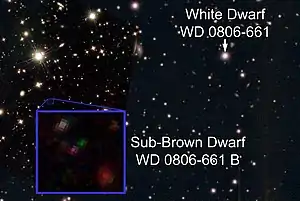WD 0806-661 b
WD 0806-661 b, also formally named Ahra, is a planetary-mass companion of the white dwarf star WD 0806-661, or Maru.
 WD 0806-661 b and its white dwarf star | |
| Discovery | |
|---|---|
| Discovery date | 2011 |
| Direct imaging | |
| Designations | |
| Ahra | |
| Orbital characteristics | |
| 2,500 AU | |
| Physical characteristics | |
Mean radius | 1.12x Jupiter (Estimate) |
| Mass | 7-9 MJ |
| 16.17 g (Estimate) | |
| Temperature | 325-350 K |
The planet was discovered in 2011 by the Spitzer Space Telescope. It has a mass of between 7-9 MJ, putting it in between the sizes of a gas giant planet and a brown dwarf. At the time of its discovery, WD 0806-661 b was the coldest brown dwarf ever discovered, with a temperature of 325-350 Kelvin (52-77 °C or 125-170 °F)[1] and also had the largest separation from its star at about 2,500 AU at the time of its discovery. The photometric colors of the object suggests it is metal-poor.[2]
As of 2021, WD 0806-661 b is a potential target for study from the James Webb Space Telescope.[3]
Host Star
WD 0806-661, or Maru, is a white dwarf star of the spectral type DQ. The metal-poor composition of its planetary companion could explain its spectral type, as it is theorized that hydrogen-deficient stars of the asymptotic giant branch could evolve into white dwarfs of spectral type DB and then DQ as they cool down.[4] WD 0806-661 is estimated to be 1.5-2.7 billion years old,[5] and likely used to be an A-type main sequence star of 2.1 ± 0.3 solar masses before reaching the end of its life and becoming a white dwarf.[6] WD 0806-661 b may have formed closer to the star, but migrated further away as it reached the end of its life.
Characteristics
Because it orbits very far away from its star, WD 0806-661 b is likely very dark, receiving almost no light from its star. However, due to the planet's high mass, internal heat keeps the temperature hotter than that of Earth.[1] The planet's radius is estimated to be 12% larger than that of Jupiter,[7] and is likely the same age as the star. Despite having temperatures comparable to that of Earth, WD 0806-661 b is a poor candidate for extraterrestrial life due to high surface gravity and lack of starlight. Because of its large mass and distance from its star, WD 0806-661 b could host many large exomoons.
The WD 0806-661 system is planned to be studied by the James Webb Space Telescope, which will probe the atmosphere of the planet, as well as search for other planetary bodies in the system.
See also
- WD 0806−661
- COCONUTS-2b - Another large planet with a large separation from its star
References
- Leggett, S. K.; Tremblin, P.; Esplin, T. L.; Luhman, K. L.; Morley, Caroline V. (2017-06-21). "The Y-Type Brown Dwarfs: Estimates of Mass and Age from New Astrometry, Homogenized Photometry and Near-Infrared Spectroscopy". The Astrophysical Journal. 842 (2): 118. arXiv:1704.03573. doi:10.3847/1538-4357/aa6fb5. ISSN 1538-4357.
- "_13428". _13428. doi:10.5270/esa-4bo1j7l. Retrieved 2023-09-09.
- "1276 - Spectroscopic Observations of WD 0806-661B" (PDF).
- Camisassa, María E.; Althaus, Leandro G.; Rohrmann, René D.; García-Berro, Enrique; Torres, Santiago; Córsico, Alejandro H.; Wachlin, Felipe C. (April 2017). "Updated Evolutionary Sequences for Hydrogen-deficient White Dwarfs". The Astrophysical Journal. 839 (1): 11. doi:10.3847/1538-4357/aa6797. ISSN 0004-637X.
- "The Extrasolar Planet Encyclopaedia — WD 0806-661 B b". exoplanet.eu. Retrieved 2023-09-09.
- Luhman, Kevin; Burgasser, Adam; Bochanski, John (2011-01-01). "Confirmation of a Candidate for the Coolest Known Brown Dwarf". Spitzer Proposal: 70203. Bibcode:2011sptz.prop70203L.
- "Exoplanet-catalog". Exoplanet Exploration: Planets Beyond our Solar System. Retrieved 2023-09-09.